
16 minute read
On an Incoming Tide, We Arrive in Friday Harbor,The Gateway to the San Juan Islands
On an Incoming Tide, We Arrive in Friday Harbor, The Gateway to the San Juan Islands By MaryRose Denton
Numerous times I traveled to Friday Harbor, an eclectic town located in the middle of San Juan Island, WA, via the hour-long ferry ride from the mainland. But I had never experienced arriving by way of the San Juan Channel.
Advertisement
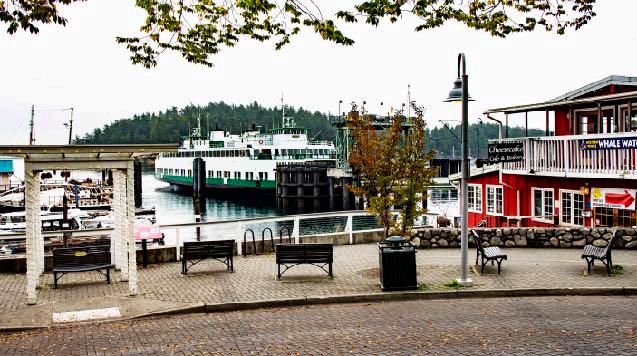
Our trip began with us hitting some very dense fog as we crossed the Strait of Juan de Fuca that morning. But as we entered the San Juan Channel and progressed north, the skies cleared a little. We began to see a shoreline of these rolling fords making up this archipelago of islands. Treelines became visible and we became aware of the shoal of porpoise following us, just off our port side.

Exquisitely beautiful scenery surrounded us allowing me for a few moments to imagine myself in the Hebrides or cruising the waterways of Norway, another land with a very similar look.
My partner Richard and I embarked on this sailing road-trip over a week prior, exploring the northern waters of the Salish Sea. Now, with the incoming tide, we cruised up the channel heading to our next port of call, Friday Harbor, known as the “Gateway to the San Juan Islands”.
Friday Harbor
This charming, seaport town offers a wide variety of culture, activities, shopping, and food. The best part, everything is within walking distance of either the ferry landing or the marina allowing visitors to experience the slower pace of “island time”.
Coming into port, a resident seal escorted us to slip #22, which would be our home for the next few days. Friday Harbor is known for its marine life from seals to the resident J,K,and L orca whale pods who call the waters around San Juan Island home. In fact, the University of Washington keeps a field station here specializing in the
Photos (From top): Birdseye view of harbor; A look at the ferry landing; Our boat Selkie docked in slip
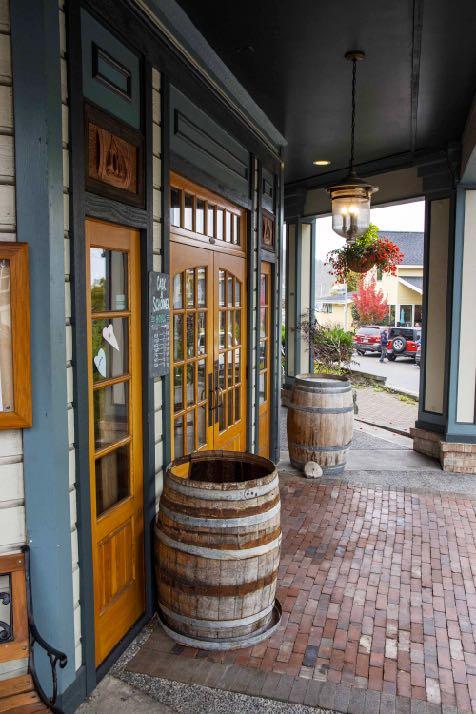
Photos (From left): Friday Harbor Marina; Friday Harbor

study of marine biology. If spotting a whale excites you, there are whale watching tours available leaving the marina daily.
After securing the boat to the dock, we found ourselves famished and ready for dinner! San Juan Bistro, a well-respected restaurant in town came highly recommended so we call in our order, letting owner Richard Daly know we can be there in 15 minutes.
Currently, San Juan Island is in Phase 2 of our state’s Safe Start Plan due to the Coronavirus. Curbside pick-up is a viable option for restaurants such as San Juan Bistro to remain open and serving their community.
Hand in hand, we strolled up Spring Street, the main outlet in this artisan town, knowing we can relax and kick back for a few days. There was no better place to be than Friday Harbor, WA.
A couple of blocks up, we turned off onto Nichols street and found the renovated home of San Juan Bistro. We waited at the top of the staircase as Richard Daly hurried out to greet us, to-go bags in hand. The waft of our dinner tantalized our senses as we walked back towards the marina. Once on board again, we settled into a magnificent farm-to-table meal beginning with a roasted carrot soup followed by a Thai Red Curry with seasonal veggies as a side dish
This area is rich in sea life as well as its agriculture, and San Juan Bistro works closely with local farmers and fishermen to bring out the flavors of this region through their gastronomy. We paired our meal with a red Malbec wine and finished the evening off savoring a slice of apple cheesecake, for two. All while we watched the sunset over the harbor as it painted the culminate clouds a light pink.
Those puffy clouds brought rain during the night, but we were in the Pacific Northwest, after all, where rain can happen unexpectedly. A slight autumn chill greeted us in the morning of day two as we headed into town for a walk, reminding us why the trees lining Spring Street were turning shades of orange.
One of my favorite places to visit while in Friday Harbor is the Whale Museum. A natural history museum founded in 1979, the Whale Museum inhabits two floors full of exhibits as well as educational resources all on marine mammals throughout the Salish Sea. There is a primary focus on the resident orca pods including a chart showing their lineage throughout the decades. I find the

whale skeletons fascinating as they so closely resemble our own. But what most impresses me is the museum’s stewardship of these whales through various educational and research programs, leaving me with a sense of hope for the future that these great giants will not be lost.

Friday Harbor is home to many artists as well as marine life. The San Juan Islands Museum of Art, located right on Spring Street, is a haven for local art exhibits from all around the Pacific Northwest. As a side note, museums make a great escape to a rainy day.
A few blocks away on Price Street is the San Juan Historical Museum. An enchanting old homestead filled with interesting stories of the people who lived on the island and shaped its history, including a full recounting of the infamous Pig War, a dispute over the sovereignty of the island which ended peacefully.
Besides visiting museums, I enjoyed meandering through the town’s small shops, which usually works up an appetite. For an early dinner, we chose to order from Mike’s Cafe and Wine Bar situated in the middle of the shopping district on

Photos (Clockwise from top left): Old Building with character; Friday Harbor Marina from Waterfront Park; Port of Friday Harbor; Peeking up Spring Street

2nd street. As a vegetarian, I find Mike’s is a go-to favorite every time I visit the island. I rest assured the “meat” in the Reuben sandwich is created from plant-based proteins, and all their menu items help in creating a more sustainable and compassionate world.
Leaving Friday Harbor
In the morning, I walked up through the waterfront park, past the totem pole and ferry landing, and turned down an alleyway leading me to the Saturday Farmers Market. A busy hubbub of shoppers greeted me as I made a beeline for fresh veggies from Mama Bird Farms. I seemed to find the secret spot for locals doing their grocery shopping. I purchased a luscious bag of mixed greens along with a bouquet of pink and red dahlias. These made a beautiful addition to the hull of our boat.
Back on the boat, it was time for our departure. Leaving Friday Harbor is always bitter-sweet, but a new port beckoned us. We pulled out of the marina with clear blue skies above us and a mild wind in our sails.
Day Tripping to Lompoc & Santa Barbara County for a Taste of Good Wine

By Cori Solomon

It does not take much to entice my husband and me to drive up to the Central Coast to go wine tasting. Santa Barbara County has so many areas to visit, including Solvang, Los Olivos, Santa Ynez, Los Alamos, and Lompoc. The various appellations of Santa Barbara County open the door to many options for tasting wine and a day trip to the area. There are wineries at every turn in all these places. If you are a lover of Chardonnay, Pinot Noir, and cool climate Syrah along with other coolclimate varieties, visiting Lompoc is the place to go, especially to the industrial park that houses the Lompoc Wine Trail, formally known as the Wine Ghetto.
Our journey is uneventful as we leave Los Angeles, but once we hit Ventura, I thoroughly enjoy the drive. We are past the hustle of Los Angeles and the San Fernando Valley. Calmness sets in as we view the the landmarks you saw in the movie Sideways. The
California coastline, but once we pass through the tunnel and start our ascent up to Buellton, we truly notice the difference. The landscape changes to pastures filled with oak trees, telling us we have arrived in Santa Barbara wine country. The Central Coast beckons us knowing we are destined to enjoy a good time.
Folded Hills
Once we hit Santa Barbara, we know that we have a 45-minute drive to Buellton's exit and the 246, the highway that leads east to Solvang and west to Lompoc. If you crave wine before you reach Buellton, stop in Gaviota at Folded Hills, the winery owned by Andrew and Kim Busch. Just off the 101 freeway, the winery is known for its Rhone varietals. From their beer empire, they now have a Farmstead lucky, you can also see the Clydesdale horses, a camel, zebra, and donkey that live in harmony on the property.
Wine Picks: Don't miss August White, a blend of Grenache Blanc, Clairette Blanche, and Roussanne. In Reds, I recommend Grant Grenache.

Wine Along the Highway 246
Back on the road for a few minutes, you will soon reach the exit of the 246 and will recognize many of that grows various crops, including grapes. If you are
film made Pinot Noir and the area famous. Heading west on the 246, you will pass several of the Sta. Rita Hills AVA vineyards and wineries, including Babcock, Foley, Dierberg, and Melville. Some of my favorites along the 246 are Dierberg and Melville. Both settings are ideal for a picnic, although with COVID, you need to check ahead of time for the specific rules.



Photos (From left): Red wine pour, Courtesy get stencil.com; Folded Hills tasting room with Kim Busch and Tymari; Dierberg Star Lane
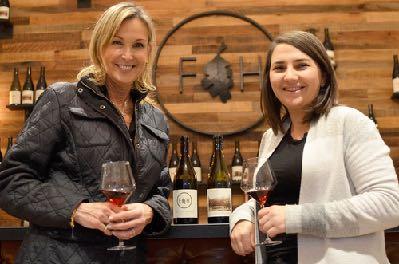
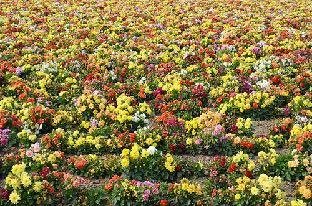


Wine Picks: At Dierberg, I have always enjoyed the unoaked Chardonnay. At Melville, I recommend the Syrah.
Sta. Rita Hills AVA
Most of the wineries in Lompoc are part of the Sta. Rita Hills AVA. It began with a vision that Michael Benedict and Richard Sanford had in the late 60s and early 70s. They planted the first vineyard in 1971, known as Sanford and Benedict, and were the pioneers of the area. By 1997 several of the pioneering winemakers were determined to make the Sta. Rita Hills, an AVA. That occurred in 2001. Today there are over 59 vineyards in the appellation.
The region is known for its Chardonnay, Pinot Noir, and other cool-climate varieties. The combination of marine-based soil with higher levels of calcium, its east/west orientation, and the diurnal changes due to the cooling influence of the Pacific ocean and fog create ideal growing conditions for cool-climate wines.
You enter the Sta. Rita Hills AVA once you are about four miles west of Buellton, and the AVA western boundary is just before you hit the town of Lompoc. The boundary on the north is the south side of the Purisima Hills and on the south the north side of the Santa Rosa Hills.
Lompoc
Lompoc is known for its flower fields, murals, and its budding wine industry. It happens to be the flower seed capital of the world. The city is about 10 to 15 minutes from Surf Beach and Ocean Beach Park for those that want to walk along the beach. Vandenberg Air Force is a 10 to fifteen-minute drive north. If you are in Lompoc on the day of a launch, look to the sky to view the rocket taking off.
The area initially was settled by the Chumash Indians. In 1787 the La Purisima Mission was established. An earthquake in 1812 destroyed the Mission. It was rebuilt in its current location and now
part of the California Park System. Before COVID-19, you could enjoy an evening under the stars at the La Purisima Mission while attending Wine and Fire, the Sta. Rita Hills Wine Alliance's yearly event. It is one of my favorite outdoor wine events.


Lompoc Wine Tasting
I discovered the wine scene in Lompoc while attending yearly dog shows in the area. I would skip a day showing my dog to explore the many wineries or enjoy a Santa Maria styled barbeque. Like Santa Maria, the barbeque is a big part of the local scene.
Wineries are scattered all over Lompoc's southern end. Most are located in an industrial park just north of Ocean Avenue near 12th St.
Some of the wineries with tasting rooms on the wine trail include Ampelos, a winery dedicated to biodynamic farming. Sampling their Rosé is a must because a small amount of Riesling enhances the spices in the wine. Sweetzer Cellars, another winery that I highly recommend where almost any of their Chardonnays and Pinots are worth tasting.
There are also wineries with tasting rooms close by but not in the industrial park—one of the newest wineries in town is Camins 2 Dreams. At Camins, try the Gruner Veltliner. Liquid Farm has a tasting room in Lompoc, as well as Los Olivos. Liquid Farm produces some of the best Burgundian Chardonnays I have ever tasted. The winery started producing only Chardonnay and Rosé, saying they would never make any Pinot Noir. A couple of years ago, they began creating Pinot Noir. Their Pinot is pretty darn good. If you run into winemaker James Sparks, ask to taste his label.
Known as the blue whale, you will find Kitá, KesslerHaak, Transcendence, and Zotovich. Although I

mention Transcendence here, my last road trip to Lompoc took me to Kessler-Haak and Kitá.
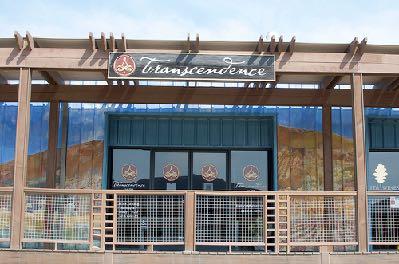
Transcendence
I have known Transcendence winemaker/owner Joey Gummere for years, and he focuses on making Chardonnay, Rosé, Pinot Noir, and Syrah. My favorite story with Joey is when I sampled the Chardonnay that goes to Japan and the same Chardonnay he produces for the US. What a difference in acidity on the Chardonnays. The version sold in Japan was off the charts with acidity. The Japanese market desires wines with very high acidity.
Kessler-Haak
Kessler-Haak Winemaker/owner Dan Kessler came from the tech industry. He started creating his wine using a box kit at home. From this elementary winemaking process, Dan won a gold medal. Dan later planted 200 plus grapevines in his backyard. As Dan's interest in wine increased, he obtained a Winemaker's Certificate from the UC Davis Distance Learning Program. All this lead to a life-changing move to Lompoc, where he purchased 40 acres along Highway 246 in 2004.
I have known Dan since 2011 and seen the growth in his wines. In 2012 Dan started to make sparkling wine and the brut with its opalesque color to this day is my favorite. Dan has challenged himself by going beyond the traditional wine of the area to experiment with


Photos (From left): Transcendence Winery; Dan Kessler of Kessler-Haak Wines; Kessler-Haak tasting room


Cabernet Franc, Nebbiolo, and Cabernet Sauvignon. My favorites at visiting his tasting room recently were the 2016 Pinot Noir Ohana Estate. Ohana means family in Hawaiian, which makes sense why this is Kessler-Haak's flagship wine. Its composition utilizes all the clones on his estate. Therefore it is a family of clones on a family estate. I also liked the 2014 Pinot Noir Intuition and the 2015 Syrah.
Kitá
The Chumash tribe owns this winery. Their winemaker Tara Gomez, a member of the Chumash tribe, overcame many challenges as both a woman winemaker and the first Native American winemaker. She represents the first Native American winery recognized in the United States. Many of Tara's philosophies on balance are carried over to her 2nd winery Camins 2 Dreams.
Both Tara's philosophy and that of the Chumash is the pursuit of balance in the winemaking process. It expresses the place, purity of the varietal, and grape. Ultimately the balance between the earth, terroir, vine, nature, and weather conditions or how we, the consumer, interprets the wine all comes into play. It is the relationship between all components of wine blended together. Balance also means giving back to the land t h r o u g h sustainable
Photos (From left)): Kita wines; The wines of Kita; Tara Gomez and the Camp 4 Vineyard







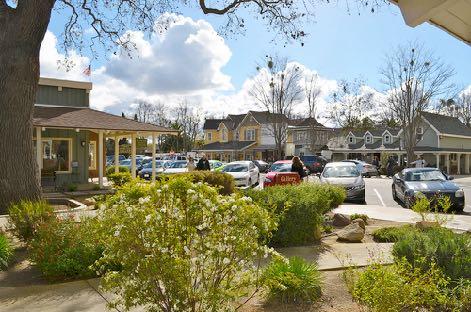

practices. All these parts signify Kitá Wines' meaning of balance.
The vineyard has a balancing spiritual quality for the Chumash. The Chumash tribe, therefore, becomes the shepherd of the vineyard. That vineyard is the Camp 4 Vineyard at the entrance to Happy Canyon AVA.
Kitá means "Our Valley Oak." The oak tree represents the tree of the Santa Ynez Valley, and like the tree, the grape signifies the fruit of the area. Therefore the wines of Kitá symbolize the essence of the Santa Ynez Valley.
At Kitá I recommend trying the 2018 T’AYA a blend of Marsanne, Roussanne and Grenache Blanc, 2018 Sauvignon Blanc, 2017 Grenache and the 2017 Syrah.
Wine Tasting in the Vicinity
Not only are their great wineries in Lompoc, but it is a 30-minute ride along the backroads to Los Alamos where you can enjoy wines, dine at Pico, or get a sandwich at Bob's Well Bread.
Buellton is 20 minutes from Lompoc, and it is worth checking out Alma Rosa's tasting room or dining at Industrial Eats, which is where we dined on our last visit.
About 30 minutes away, Solvang offers a cute Danish atmosphere with wonderful pastry shops, gift shops, and restaurants. Some of my favorite wine tasting rooms are Wandering Dog Wine Bar, Crawford Family Wines, where you must try their Albarino, Lucas and Lewellen, and Buttonwood.
Los Olivos, a quaint town approximately 40 minutes away from Lompoc, offers many wine tasting rooms. My favorites are Tercero, Liquid Farm, and Andrew Murray.
Whether you visit Lompoc, Los Alamos, Buellton, Solvang, or Los Olivos, you will certainly enjoy a wonderful day of wine tasting. For me, Lompoc holds a special place in my heart because it is where I learned so much about the nuances of wine and wine writing.
Photos (From top): The town of Solvang; La Parisima Mission; Los Olivos; Melville Winery










